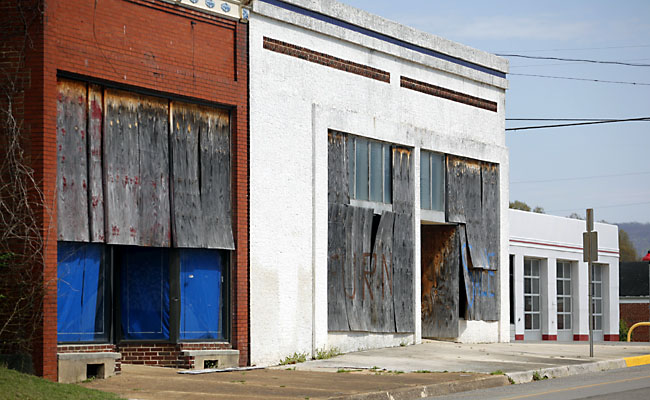BRIDGEPORT, Ala.-Standing behind the counter of her cluttered sporting goods store, Kendal Storey is not surprised to learn that her town is one of the tri-state area's shrinking cities.
Bear Bryant portraits on the shop's wall outnumber the cars passing on the street downtown. The town's single stoplight, which used to control flowing traffic, now only flashes yellow for the occasional car.
"It's kind of gotten smaller as it goes on," she said.
Funerals and Civil War re-enactments are about the only action in town, she said.
According to 2010 census figures, Bridgeport lost 300 residents, or about 11.4 percent of its population, since the 2000 census. The town's service station recently shut down, joining the row of other boarded-up buildings downtown.
Bridgeport; South Pittsburg, Tenn.; and Trion, Ga., are among the troubled towns in the tri-state region that census figures show lost population from 2000 to 2010.
Trion fell from 1,993 residents to 1,827, an 8.3 percent loss. Bridgeport dropped 11.36 percent, from 2,728 to 2,418. Just across the state line, South Pittsburg fell from 3,295 to 2,992, a 9.2 percent loss.
Overall, the 23 counties in the tri-state area added nearly 123,000 residents, growing by 11 percent. Several Northwest Georgia cities lead the way with Calhoun, Chickamauga, Ringgold and Fort Oglethorpe all increasing by at least 30 percent.
The counties around Trion and South Pittsburg also grew, with Chattooga County in Georgia gaining nearly 10 percent and Marion County gaining 2 percent. Jackson County, Ala., where Bridgeport is located, had an overall decline of 1.3 percent.
That is, if you trust the census numbers.
"I don't believe it's accurate. I just can't see where we've lost population," said South Pittsburg Vice Mayor Charles Reynolds. "Any loss of any amount doesn't seem accurate to me."
A 2009 annexation of about two dozen homes and seemingly stable residency figures cause him to question the numbers, he said.
"We picked up some people down next to the state line, and we haven't lost any up this way that I know of," Reynolds said.
He wants to study the figures and talk to city commissioners before deciding whether to appeal the count.
Population affects how much state and federal funding towns receive. A loss could hurt a city's efforts to lure industry and other businesses, city officials said.
Officials in Pikeville, Tenn., plan to challenge their results. Mayor Greg Johnson said that for every person not counted, the city would lose about $110 in state shared funds. In that context, losing 173 residents, as reported in the census, could cost the city more than $19,000.
"I just want to make sure it's accurate. It's very important," he said. "If it's accurate, that's fine, but I just don't feel like it is."
Doug Bachtel, a demographer with the University of Georgia, said questioning the figures is a "normal reaction" for officials in shrinking cities.
"It's really hard to count everybody and inevitably some people will fall through the cracks," he said. "But all in all, the Census Bureau does a good job."
South Pittsburg High School's enrollment has declined, according to Tennessee Report Card data. Enrollment was 359 in 2010, compared with 412 in 2000, records show.
In Bridgeport, Mayor David "Bubba" Hughes is a little more accepting of the numbers.
"I kind of figured [a decline] because we've got a bunch of empty houses," said Hughes.
According to census data, 13 percent of Bridgeport's housing units were empty in 2010, compared with 11 percent in 2010.
Lifelong Bridgeport resident Roy Rankin said he remembers a bustling town decades ago.
"Bridgeport when I was a kid was a very, very busy place," he said. "It's just slowly left."
Glenn Hill, curator of the Bridgeport Area Historical Association Museum, said the city was built around the railroad and the Tennessee River and once was a hub for building riverboats and other industries. Some of the manufacturing jobs still are around, but not as many.
Then in the 1990s, U.S. Highway 72 was widened, allowing traffic to bypass Bridgeport's downtown. A natural gas explosion in 1999 took out 12 downtown buildings.
"It just absolutely killed downtown," said Hill. "It's like somebody was trying to wipe it off the face of the Earth."
Many residents sought jobs out of town and moved away, he said.
Bachtel said that is typical of many small towns across the country.
"The history of America is sort of the demise of small towns. People are moving to the big cities. It's been happening since the 1790s," he said.
The census counted fewer housing units in all three cities.
South Pittsburg lost 67 units and Bridgeport lost 131 units, according to the data, while Trion dropped 140 units or 18 percent.
"I don't buy that at all," said Trion Mayor Johnny Ingle.
He said most of the 54 apartments damaged by severe flooding in 2009 were unoccupied, but have not been condemned officially. He knew of one or two houses that burned over the decade, but he couldn't see any way the losses added up to 140.
Trion's major industry, denim producer Mount Vernon Mills, has slowed operations, which could have forced some workers out, Ingle surmised.
But he still thinks something's fishy about the numbers.
"We're thinking they may not have gotten all of the folks counted," he said. "We're probably going to look at a few things down the road."
Hughes said he's seen Bridgeport ebb and flow over the past few decades.
"I've seen it where you can't find a place to rent and other times where there are empty houses," he said. "It's a bad thing to lose population, but for Bridgeport I think it's just part of a cycle."
Contact staff writer Andy Johns at ajohns@timesfree press.com or call 423-757-6324.
Contact staff writer Ben Benton at 423-757-6569 or bbenton@timesfreepress.com.

